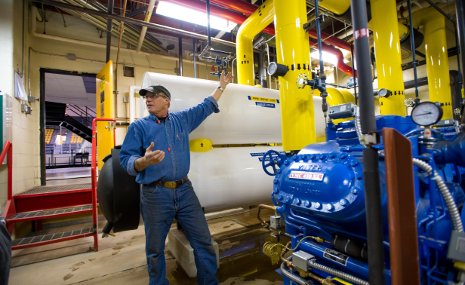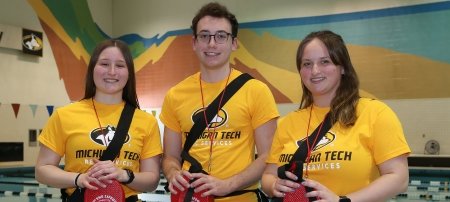Michigan Tech Ice Rink Goes Green

Question: What can make both ice and heat and reduce Michigan Technological University’s carbon footprint while doing so?
Answer: Michigan Tech’s new ice-making system at the John J. MacInnes Student Ice Arena. The ammonia brine-based system not only makes ice for the hockey rink, it heats the rink’s sub-floor, preventing frost from forming under the insulated concrete slab. Heat generated as the ammonia is compressed to be used as a refrigerant heats 100 percent of the hot water used in the arena and maintains a comfortable water temperature for the nearby swimming pool and dive tank.
Michigan Tech replaced its ice-making system last summer, removing the building’s original Freon 22 direct system and installing an ammonia brine indirect system.
The reviews of the ice from rink users have been positive, but the most impressive part of the new system might be its reduced impact on the environment and the University’s budget.
“What you have is the most environmentally-friendly and energy-efficient system available,” said Mark Rodorigo, owner and CEO of Commercial Refrigeration of Virginia, Minn., which did the initial installation of the new system. “We replaced the Freon R-22, which is an ozone-depleting chemical, with anhydrous ammonia, an all-natural substance. Plus, we’re reclaiming the waste heat. You have reduced your carbon footprint tremendously.”
Here’s how it works. A calcium chloride (saltwater) brine is chilled by the anhydrous ammonia refrigerant in a large shell and tube heat exchanger called the “chiller.” The brine leaves the chiller and is pumped through 13 miles of tubing inside the rink’s concrete slab. It leaves the mechanical room at 12 degrees Fahrenheit and returns a few degrees warmer back into the chiller.
Heat is created when the ammonia is compressed to be used as a refrigerant, producing a high-temperature gas that travels to three large water tanks that heat all the hot water used in the arena. The gas also feeds into a titanium-plated heat exchanger that heats the swimming pool and dive tank.
The last step in the ice-making process is the final cooling of the gas by an evaporative condenser. Because going through the water tanks and heat exchanger has already cooled the gas somewhat, the condenser requires less energy, water and chemicals.
The subfloor is heated using the waste heat from the compressor crankcase oil. The hot oil is pumped through a small heat exchanger, where it is cooled. The heat is then sent through the rink subfloor to prevent frost from forming under the insulated concrete slab.
Dave Nordstrom, Michigan Tech’s associate athletic director and building manager for the Student Development Complex and ice arena, is extremely pleased with performance of the new ice plant. “This new system is not only better for the environment, it’s going to save the University thousands of dollars,” said Nordstrom.
Early estimates put the annual savings at $40,000.
“Anhydrous ammonia is a lot cheaper than R-22,” Rodorigo explained. “You’re also saving money on heating your hot water, your swimming pool and your subfloor. And you’re saving money on water and chemicals used in the evaporation condenser because you’re not emitting as much heat into the atmosphere.
“I would think that a lot of other universities would be looking at this system.”
The John J. MacInnes Student Ice Arena was built in 1971. It is home to the Michigan Tech Huskies hockey team and is used for many other purposes as well, including high school and youth hockey games, figure skating, concerts and the University’s spring commencement.
Michigan Technological University is an R1 public research university founded in 1885 in Houghton, and is home to nearly 7,500 students from more than 60 countries around the world. Consistently ranked among the best universities in the country for return on investment, Michigan's flagship technological university offers more than 185 undergraduate and graduate degree programs in science and technology, engineering, computing, forestry, business, health professions, humanities, mathematics, social sciences, and the arts. The rural campus is situated just miles from Lake Superior in Michigan's Upper Peninsula, offering year-round opportunities for outdoor adventure.




Comments